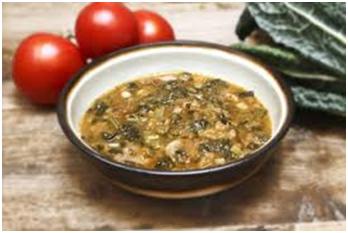Ribollita
There are two major categories of Italian hearty soups, or zuppe: those based on legumes of some sort, beans, chick peas, lentils, or whatever, added with grains or pasta, like farro or barley; and those that are based on green vegetables — minestroni, in short.
In sight of the upcoming monumental holiday menus, a warm bowl of healthy minestra works wonders on the overworked digestive system. Plus dinosaur kale is starting to appear on market stalls, so Ribollita makes its yearly debut on my dinner table. Finalmente.

Probably the most representative of Tuscany’s zuppa tradition, Ribollita honorably competes with co-regional adversaries Pappa al Pomodoro and Zuppa di Farro for the title of the world’s best hearty Italian minestra. Ribollita was the soup typical of Tuscan farmers, and represented the feast of the harvest. Today it is a classic cuisine delicacy, often mis-interpreted and served at white tablecloth restaurants in bowls the size of a thimble. Heresy. Ribollita spells abundance! And thrift! End of rant.
After a first slow stewing, the vegetable-loaded ribollita is left to rest and re-boiled (hence the name, ri-bollita) the next day.
Cavolo Nero–the main ingredient of this twice-cooked bread and vegetable minestrone–is black leaf kale. Some English-speakers call it with its original name cavolo nero, while others refer to it as ‘dinosaur kale’ or ‘laciniate kale’ or ‘Tuscan kale’.
If you live in the southern hemisphere and it’s not exactly cavolo nero season now, here’s a trick: adding a sprig of fresh thyme in the preparation magically lends the soup a cavolo nero-flavor. I swear.
There are many variations and family copyrighted recipes for Ribollita. My version is inspired by a combination of the one shared by Artusi, and the version of a Florentine housekeeper that taught my mom this recipe years ago.
- 500 gr (3 1/2 cups) cannellini beans*
- 1 leek, trimmed of all green parts and thinly sliced
- 1 carrot, diced
- 1 large (or 2 medium) celery ribs, diced
- 5 tbsp extra virgin olive oil
- 3 tbsp tomato sauce
- 500 gr (2 cups) kale (essential!)
- 4 plum tomatoes, peeled and chopped
- 1 large onion, finely chopped
- 2 potatoes, peeled and diced
- 2 zucchini, diced
- 1/2 large Savoy cabbage
- 250 gr (1 cup) Swiss chard
- 4 slices of day-old (or stale) homestyle bread, roughly torn apart
- 1 tsp salt and generous lashings of cracked black pepper
(A sprig of fresh thyme in substitution of kale)
*If the beans are dried, soak them in water for at least 24 hours; if fresh or canned, simply rinse after removing them from their pods or cans.
You’ll be making this dish the day before serving your Ribollita, so be sure to budget time wisely.
Rinse the beans and boil them in salted water for 40 minutes. Set them aside soaking in their cooking water.
Sauté the leek-carrot-celery holy trinity mirepoix with olive oil, in a heavy bottomed pot. When the leek is translucent, add the tomato sauce. Puree half the beans in the blender with their cooking water and add them to the sauce base.
Stir in all the vegetables, and bring to a boil, then reduce heat and simmer gently for 1 hour.
Fold in the rest of the saved beans and the bread, seasoning to taste with salt and pepper. Keep simmering for 5 more minutes.
Turn off the stove, go to sleep and wish your Ribollita goodnight.
The next day re-boil the soup for 10 minutes and let it rest off the stove for an additional 15 minutes before serving in deep bowls, each containing a garlic-rubbed slice of bruschetta, a drizzle of raw extra virgin olive oil, and several more turns of the pepper mill.
The wine you should pour with Ribollita should be preferably three things: Tuscan, red and intense. I would go with the earthy Cecchi Bonizio, a marvelous blend of Merlot from Tuscany’s coastal Maremma zone, and select Sangiovese grapes from the hills of Chianti Classico, loaded with lots of wild berries, spice and complexity, perfect with the round, full and rich mouthfuls of warm, comforting vegetables.
[wp_bannerize group=”scuola” limit=”1″]
